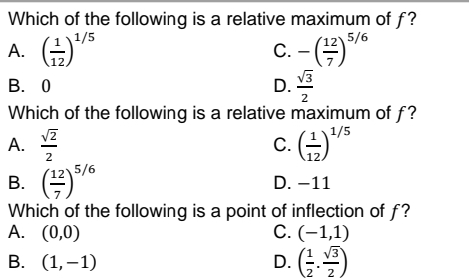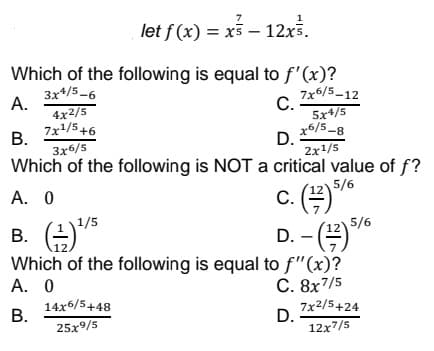let f (x) = x3 – 12x3. Which of the following is equal to f'(x)? 3x*/5-6 А. 4x2/5 7x/5+6 В. 3x6/5 7x6/5-12 C. 5x4/5 x6/5-8 D. 2x1/5 Which of the following is NOT a critical value of f? 5/6 А. 0 c. (2) 5/6 B. * D. - (* Which of the following is equal to f"(x)? C. 8x7/5 1/5 А. 0 14x6/5+48 В. 7x2/5+24 D. 12x7/5 25x/5
let f (x) = x3 – 12x3. Which of the following is equal to f'(x)? 3x*/5-6 А. 4x2/5 7x/5+6 В. 3x6/5 7x6/5-12 C. 5x4/5 x6/5-8 D. 2x1/5 Which of the following is NOT a critical value of f? 5/6 А. 0 c. (2) 5/6 B. * D. - (* Which of the following is equal to f"(x)? C. 8x7/5 1/5 А. 0 14x6/5+48 В. 7x2/5+24 D. 12x7/5 25x/5
Calculus: Early Transcendentals
8th Edition
ISBN:9781285741550
Author:James Stewart
Publisher:James Stewart
Chapter1: Functions And Models
Section: Chapter Questions
Problem 1RCC: (a) What is a function? What are its domain and range? (b) What is the graph of a function? (c) How...
Related questions
Question
100%

Transcribed Image Text:Which of the following is a relative maximum of f?
'12\5/6
1/5
A. *
C. - ()
С.
В. О
V3
D.
2
Which of the following is a relative maximum of f?
1/5
c.
С.
A.
2
(12)5/6
D. -11
В.
Which of the following is a point of inflection of f?
С. (-1,1)
D. ()
А. (0,0)
В. (1,-1)
2 2

Transcribed Image Text:7
let f (x) = x – 12x.
Which of the following is equal to f'(x)?
3x*/5-6
А.
4x2/5
7x1/5+6
В.
3x6/5
Which of the following is NOT a critical value of f?
7x6/5-12
С.
5x+/5
x6/5-8
D.
2x1/5
A. 0
C.
5/6
1/5
B. +*
Which of the following is equal to f"(x)?
А. 0
D. - *
12) 5/6
12
C. 8x7/5
14x6/5+48
В.
7x2/5+24
D.
12x7/5
25x9/5
Expert Solution
This question has been solved!
Explore an expertly crafted, step-by-step solution for a thorough understanding of key concepts.
Step by step
Solved in 2 steps with 1 images

Follow-up Questions
Read through expert solutions to related follow-up questions below.
Follow-up Question

Transcribed Image Text:Which of the following is a relative maximum of f?
1/5
A. (²¹²
c. - (12) 5/6
√√3
B. 0
D.
2
Which of the following is a relative maximum of f?
1/5
A.
√2
2
c. (1) ¹
B. (1) 5/6
D. -11
Which of the following is a point of inflection of f?
A. (0,0)
C. (-1,1)
B. (1,-1)
D. (13. 1/2)
Solution
Recommended textbooks for you

Calculus: Early Transcendentals
Calculus
ISBN:
9781285741550
Author:
James Stewart
Publisher:
Cengage Learning

Thomas' Calculus (14th Edition)
Calculus
ISBN:
9780134438986
Author:
Joel R. Hass, Christopher E. Heil, Maurice D. Weir
Publisher:
PEARSON

Calculus: Early Transcendentals (3rd Edition)
Calculus
ISBN:
9780134763644
Author:
William L. Briggs, Lyle Cochran, Bernard Gillett, Eric Schulz
Publisher:
PEARSON

Calculus: Early Transcendentals
Calculus
ISBN:
9781285741550
Author:
James Stewart
Publisher:
Cengage Learning

Thomas' Calculus (14th Edition)
Calculus
ISBN:
9780134438986
Author:
Joel R. Hass, Christopher E. Heil, Maurice D. Weir
Publisher:
PEARSON

Calculus: Early Transcendentals (3rd Edition)
Calculus
ISBN:
9780134763644
Author:
William L. Briggs, Lyle Cochran, Bernard Gillett, Eric Schulz
Publisher:
PEARSON

Calculus: Early Transcendentals
Calculus
ISBN:
9781319050740
Author:
Jon Rogawski, Colin Adams, Robert Franzosa
Publisher:
W. H. Freeman


Calculus: Early Transcendental Functions
Calculus
ISBN:
9781337552516
Author:
Ron Larson, Bruce H. Edwards
Publisher:
Cengage Learning